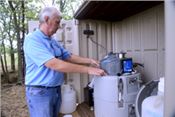|
Soil Scientists Prepare To Mark 350 Years Since Discovery Of ‘Cold Fire’

Andrew Sharpley, professor of crop, soil and environmental sciences, calibrates an automated
sampler for a sampling site along a stream at the border of a Washington County farm field.
UA Division of Agriculture photo by Fred Miller
FAYETTEVILLE, ARK.
In 1669, alchemist Hennig Brandt was looking for the “philosopher’s stone,” a legendary device believed to be able to turn base metals into gold. So it was quite by accident that he discovered “cold fire.”
Soil scientists will celebrate the 350th anniversary of the discovery of phosphorus during a conference of the Soil Science Society of America in January 2019, said Andrew Sharpley, Distinguished Professor of Soils and Water Quality for the University of Arkansas System Division of Agriculture.
Brandt called his discovery “cold fire,” because it glowed in the dark. Later, he gave it the scientific name phosphorus mirabilis, meaning “miraculous bearer of light.”
It was the 13thelement, and the first discovered by scientific methodology.
Brandt distilled phosphorus from a copious store of human urine – it took about 290 gallons to produce a little more than 2 ounces of the stuff.
“Ironically, we are still trying to find efficient and cost-effective methods to extract phosphorus from human and animal excreta,” Sharpley said, “which goes to show how little some things have changed over the last three and a half centuries.”
Phosphorus is inextricably linked to human society since the industrial age, Sharpley said. It has moved beyond its agricultural uses and has become essential to many industries.
Most commercial phosphorus comes from mineral mines, Sharpley said. It’s a finite resource, though estimates on when easily available sources run out vary widely.
Phosphorus from animal manure has long been used for agricultural fertilizer, Sharpley said, but as animal agriculture has become uncoupled from plant agriculture, some areas see overabundance while others see shortages. The problem is a global one, he said.
“We face a conundrum of coincident consequences of phosphorus deficiencies and excesses,” Sharpley said.
Taking Stock
Sharpley said 2019 will be a good time to envision the next 350 years of research and discovery.
“The 350thanniversary of our relationship with phosphorus presents an ideal vantage point from which to consider where we have been, where we are, and where we should take this relationship,” Sharpley said.
Phosphorus is an essential nutrient for agricultural crops, Sharpley said, but it can become a problem when too much of it builds up in soils. Under some circumstances, rainwater can move phosphorus from dry land into bodies of water, where its nutrient properties may result in explosive growth of algae and reduced water quality.
“Our research faculty are involved in tackling these issues, collaborating with scientists at other universities and in other countries to tackle the issues worldwide,” Sharpley said.
Division researchers in the Arkansas Agricultural Experiment Station have long studied phosphorus management in Arkansas, Sharpley said. The results have included comprehensive best management practices that sharply reduce the risk of runoff.
Ongoing research continues to refine those practices, Sharpley said.
The Division of Agriculture partners with Arkansas farmers on Discovery Farms, where where nutrient use, including phosphorus, is monitored, Sharpley said. New management methods are tested on those working farms to determine their effectiveness in reducing or eliminating nutrient loss.
Division of Agriculture scientists are investigating new conservation methods and new ways of using old methods, Sharpley said.
Such research includes the use of reduced tillage and cover crops. Sharpley said these practices act by protecting the surface of the soil and reducing erosion.
Such practices not only help prevent nutrient loss, Sharpley said, but also help build up organic matter and sequester carbon, improving soil health and reducing agriculture’s carbon footprint.
“Some of these practices have been around a long time,” Sharpley said. “They’re good common sense and farmers use them.”
The Discovery Farms and other research documents their effectiveness for conserving nutrients and allowing farmers to use less fertilizer.
Research data is provided to agencies like the National Resource Conservation Service that uses it to develop regulatory measures that reduce environmental impacts. Sharpley said division scientists follow up to measure the effectiveness of those practices.
“Farmers do not deliberately permit nutrient loss,” Sharpley said, “They are keen to use some of these conservation systems as research proves their effectiveness.”
Sharpley said scientists are also looking toward a future where mineral phosphorus reserves are no longer available.
“This will require collaboration along the supply chain to engage in sustainable phosphorus stewardship,” Sharpley said. “It will require broadening the four current ‘Rs’ of nutrient management for phosphorus to reduce loss and waste, recover from wastes, reuse it and restructure production sectors.”
“For instance, a lot of phosphorus is wasted in food,” Sharpley said. “Around 70 percent of phosphorus in food is wasted. How can it be recovered?”
Scientists are already looking at more efficient ways to extract phosphorus nutrient from manures and use them as a beneficial byproduct, he said. ∆
|
|